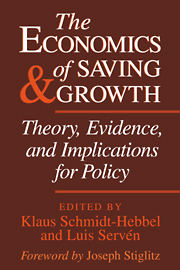1 - Introduction
Published online by Cambridge University Press: 18 December 2009
Summary
Attempts by economists to understand the savings and consumption patterns of households have generated some of the best science in economics. For more than fifty years, there has been serious empirical and theoretical activity, and the two strands have never been long separated as has happened in so many other branches of economics.
Angus Deaton, Understanding Consumption, Oxford, 1992.Over the past three decades the world has witnessed a steady decline in its overall saving rate. This trend decline conceals widely diverging regional saving patterns, particularly within the developing world: saving rates have doubled in East Asia, stagnated in Latin America, and collapsed in sub-Saharan Africa. These saving disparities have been closely reflected in the respective growth performances: across world regions, higher saving rates have come with higher income growth.
Why are these saving disparities of any interest? From a theoretical viewpoint, there is in principle little reason to expect saving rates to behave similarly across countries. In an ideal first-best world, different saving rates could just be the result of optimal intertemporal consumption decisions when preferences, technology, demographics, and/or other factors vary across countries. In the real second-best world, however, intertemporal choices are subject to a host of externalities, market failures, and policy-induced distortions that in many countries are likely to cause saving to differ from its welfare-maximizing levels. Of course, the result need not be too low a level of saving.
- Type
- Chapter
- Information
- The Economics of Saving and GrowthTheory, Evidence, and Implications for Policy, pp. 1 - 5Publisher: Cambridge University PressPrint publication year: 1999
- 5
- Cited by



